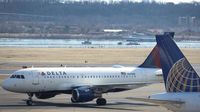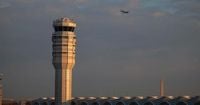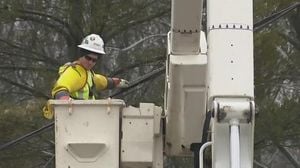A Delta Air Lines flight departing Ronald Reagan National Airport near Washington, D.C., experienced a close call with an Air Force jet just after takeoff Friday afternoon, authorities confirmed. Both flights ultimately continued to their destinations without incident.
The situation occurred just after Delta Flight 2983, an Airbus A319, had taken off from Reagan International at around 3:15 p.m. Eastern Time bound for Minneapolis, Minnesota, the Federal Aviation Administration (FAA) said in a statement. Meanwhile, four U.S. Air Force T-38 Talons were in the area heading to Arlington National Cemetery for a flyover, according to the FAA.
Air traffic data from FlightRadar.com indicated that one of the T-38 jets was at an altitude of 875 feet. The Delta flight had 131 passengers, two pilots, and three flight attendants on board at the time, a Delta spokesperson confirmed to CBS News.
Shortly after the close call, one of the Delta pilots asked Reagan air traffic controllers, "Was there an actual aircraft about 500 feet below us as we came off DCA?" The departure controller responded, "Delta 2983, affirmative," according to audio from LiveATC.net.
In response to the alert, air traffic controllers issued corrective instructions to both aircraft. The Delta spokesperson said the flight crew also followed instructions from the Traffic Alert and Collision Avoidance System (TCAS), an FAA device used to reduce the risk of mid-air collisions. "Nothing is more important than the safety of our customers and people," a spokesperson for Delta said in a statement to CBS News. "That's why the flight crew followed procedures to maneuver the aircraft as instructed."
The FAA stated it will investigate the incident, which comes just two months after a fatal collision at the same airport between an airliner and an Army helicopter, killing 67 people. In response to that tragedy, the FAA announced it would drastically limit helicopter flights near the airport.
Earlier this month, at a news conference, National Transportation Safety Board (NTSB) chairwoman Jennifer Homendy called the flight patterns around DCA "an intolerable risk," pointing to how helicopters and commercial planes operate in close proximity within an already busy airspace. The NTSB's preliminary report on the deadly crash revealed that between October 2021 and December 2024, there were more than 15,000 occurrences of close calls between commercial planes and helicopters, defined as situations where two aircraft were separated by less than 6,100 feet laterally and less than 400 feet vertically.
In that three-year span, there were 85 recorded incidents where aircraft were apart by less than 1,500 feet laterally and less than 200 feet vertically. Tracking data from FlightRadar24 on Friday showed that there was a brief moment when both the Delta plane and the military aircraft were flying above the same area of the Potomac River near Alexandria's Potomac Yard.
In the aftermath of the incident, Democratic Senator Amy Klobuchar of Minnesota expressed her concerns, labeling the situation "unbelievably dangerous." She announced her intention to reach out to the Pentagon, stating, "My first call to the Department of Defense tomorrow: why are your planes flying 500 feet below passenger jets full of Minnesotans headed from DCA to my state?"
The FAA's investigation will likely focus on the protocols in place for military aircraft operating in proximity to commercial flights, especially in light of the recent fatal incident. The agency is under pressure to ensure the safety of air travel as incidents of near misses continue to rise.
As the aviation community awaits the findings of the FAA's investigation, the incident underscores the ongoing challenges of managing air traffic in one of the busiest airspaces in the United States. With the number of close calls increasing, officials are calling for a reassessment of flight patterns and safety measures to prevent future accidents.
In the wake of the recent close call, Delta Air Lines has reiterated its commitment to safety. A spokesperson stated, "We take every incident seriously and will cooperate fully with the FAA's investigation to ensure the safety of our passengers and crew." The airline's adherence to TCAS protocols during the incident reflects a broader commitment to aviation safety standards.
As aviation safety remains a paramount concern, the FAA's findings could lead to significant changes in how military and commercial flights operate in shared airspace. The outcome of the investigation may prompt a reevaluation of existing regulations governing air traffic control, aiming to enhance safety for all aircraft operating in the vicinity of busy airports like Reagan National.
With the aviation industry still reeling from the aftermath of the tragic collision earlier this year, stakeholders are hopeful that this latest incident will serve as a catalyst for change. Ensuring the safety of passengers and crew alike is a responsibility that falls on both airlines and regulatory bodies, and the hope is that lessons learned from these close calls will lead to improved protocols and oversight.
As the investigation unfolds, both Delta and the FAA will be under scrutiny as they navigate the complexities of air traffic management. The outcome will not only impact the airlines involved but could also reshape the landscape of air travel safety in the United States.





